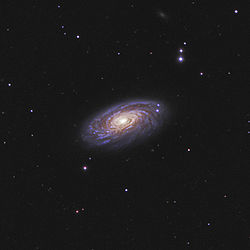- Messier 88
-
For the Armoured Recovery Vehicle, see M88 Recovery Vehicle
Messier 88 
Spiral Galaxy Messier 88 Observation data
Epoch J2000Constellation Coma Berenices Right ascension 12h 31m 59.2s[1] Declination +14° 25′ 14″[1] Apparent dimension (V) 6.9 × 3.7 moa[1] Apparent magnitude (V) 10.4[1] Characteristics Type SA(rs)b, HII Sy2[1] Astrometry Helio Radial velocity 2281 ± 3[1]km/s Redshift 0.007609 ± 0.000010[1] Galactocentric Velocity 2235 ± 4 km/s Distance 47 ± 8 Mly (14 ± 2.5 Mpc) Other designations Database references SIMBAD Search M88 data See also: Galaxy, List of galaxies Messier 88 (also known as M88 or NGC 4501) is a spiral galaxy about 47 million light-years away[citation needed][dubious ] in the constellation Coma Berenices. It was discovered by Charles Messier in 1781.
Contents
Properties
This galaxy is one of the fifteen Messier objects that belong the nearby Virgo Cluster of galaxies. It is galaxy number 1401 in the Virgo Cluster Catalogue (VCC) of 2096 galaxies that are candidate members of the cluster.[2] This galaxy may be on a highly elliptical orbit that is carrying it toward the cluster center, which is occupied by the giant elliptical galaxy M87. NGC 4501 is currently 0.3–0.48 million parsecs from the center and will come closest to the core in about 200–300 million years. The motion of this galaxy through the intergalactic medium of the Virgo cluster is creating a ram pressure that is stripping away the outer region of neutral hydrogen. This stripping has already been detected along the western, leading edge of the galaxy.[3]
 M88 by Hubble space telescope
M88 by Hubble space telescope
This galaxy is inclined to the line of sight by 64°.[4] It is classified as an Sbc spiral, which lies between the Sb and Sc categories of medium-wound and loosely-wound spiral arms, respectively. The arm structure of the spirals is very regular and can be followed down to the galactic core.[5] The maximum rotation velocity of the gas is 241.6 ± 4.5 km/s.[6]
This is classified as a type 2 seyfert galaxy, which means it produces narrow spectral line emission from highly ionized gas in the galactic nuclei.[7] In the core region there is a central condensation with a 230 parsec diameter, which has two concentration peaks. This condensation is being fed by inflow from the spiral arms.[8] The supermassive black hole at the core of this galaxy has 107.9 solar masses, or about 80 million times the mass of the Sun.[9]
In 1999, supernova 1999cl was discovered in this galaxy.[10]
See also
References
- ^ a b c d e f g h "Results for NGC 4501". NASA/IPAC Extragalactic Database. California Institute of Technology. http://nedwww.ipac.caltech.edu/cgi-bin/nph-objsearch?objname=Messier+88&img_stamp=yes. Retrieved 2006-11-14.
- ^ Binggeli, B.; Sandage, A.; Tammann, G. A. (1985). "Studies of the Virgo Cluster. II - A catalog of 2096 galaxies in the Virgo Cluster area". Astronomical Journal 90: 1681–1759. Bibcode 1985AJ.....90.1681B. doi:10.1086/113874.
- ^ Vollmer, B. et al. (2008). "Pre-peak ram pressure stripping in the Virgo cluster spiral galaxy NGC 4501". Astronomy and Astrophysics 483 (1): 89–106. Bibcode 2008A&A...483...89V. doi:10.1051/0004-6361:20078139.
- ^ Tully, R. B.; Fisher, J. R.; Fisher (1977). "A new method of determining distances to galaxies". Astronomy and Astrophysics 54 (3): 661–673. Bibcode 1977A&A....54..661T.
- ^ Möllenhoff, C.; Heidt, J. (2001). "Surface photometry of spiral galaxies in NIR: Structural parameters of disks and bulges". Astronomy and Astrophysics 368 (1): 16–37. Bibcode 2001A&A...368...16M. doi:10.1051/0004-6361:20000335.
- ^ "Database for physics of galaxies". HyperLeda. Université de Lyon. http://leda.univ-lyon1.fr/. Retrieved 2009-09-16.
- ^ L. S. Sparke, J. S. Gallagher III (2007). Galaxies in the Universe: An Introduction. Cambridge University Press. ISBN 0-521-67186-6.
- ^ Onodera, S.; Sofue, Y.; Koda, J.; Nakanishi, H.; Kohno, K. (2002). "CO (J=1-0) Observations of the Non-Barred Seyfert 2 Galaxy NGC 4501". In Ikeuchi, S.; Hearnshaw, J.; Hanawa, T.. Proceedings of the IAU 8th Asian-Pacific Regional Meeting. Bibcode 2002aprm.conf..199O.
- ^ Merloni, Andrea; Heinz, Sebastian; di Matteo, Tiziana (2003). "A Fundamental Plane of black hole activity". Monthly Notices of the Royal Astronomical Society 345 (4): 1057–1076. arXiv:astro-ph/0305261. Bibcode 2003MNRAS.345.1057M. doi:10.1046/j.1365-2966.2003.07017.x.
- ^ James, N. D. (1999). "Supernova 1999cl in NGC 4501 (M88)". Journal of the British Astronomical Association 109 (4): 178. Bibcode 1999JBAA..109..178J.
External links
- Spiral Galaxy M88 @ SEDS Messier pages
- Messier 88 on WikiSky: DSS2, SDSS, GALEX, IRAS, Hydrogen α, X-Ray, Astrophoto, Sky Map, Articles and images
Coordinates:
 12h 31m 59.2s, +14° 25′ 14″
12h 31m 59.2s, +14° 25′ 14″Messier objects List M1 · M2 · M3 · M4 · M5 · M6 · M7 · M8 · M9 · M10 · M11 · M12 · M13 · M14 · M15 · M16 · M17 · M18 · M19 · M20 · M21 · M22 · M23 · M24 · M25 · M26 · M27 · M28 · M29 · M30 · M31 · M32 · M33 · M34 · M35 · M36 · M37 · M38 · M39 · M40 · M41 · M42 · M43 · M44 · M45 · M46 · M47 · M48 · M49 · M50 · M51 · M52 · M53 · M54 · M55 · M56 · M57 · M58 · M59 · M60 · M61 · M62 · M63 · M64 · M65 · M66 · M67 · M68 · M69 · M70 · M71 · M72 · M73 · M74 · M75 · M76 · M77 · M78 · M79 · M80 · M81 · M82 · M83 · M84 · M85 · M86 · M87 · M88 · M89 · M90 · M91 · M92 · M93 · M94 · M95 · M96 · M97 · M98 · M99 · M100 · M101 · M102 · M103 · M104 · M105 · M106 · M107 · M108 · M109 · M110See also  Book:Messier objects ·
Book:Messier objects ·  Category:Messier objects
Category:Messier objects  Portal:AstronomyCategories:
Portal:AstronomyCategories:- Spiral galaxies
- Unbarred spiral galaxies
- Virgo Cluster
- Coma Berenices constellation
- Messier objects
- NGC objects
- UGC objects
- PGC objects
Wikimedia Foundation. 2010.

